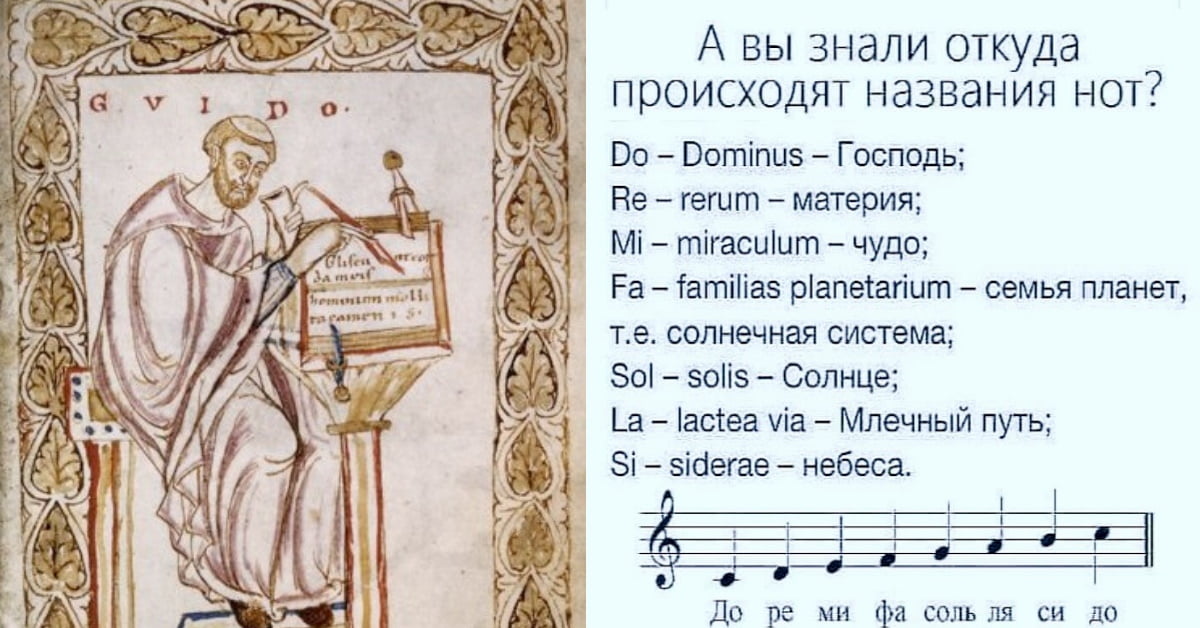According to popular theory, the names of the notes are derived from a number of Latin concepts with religious and cosmological implications. We checked if this is true.
In recent years, a number of the same type have been circulating on social networks. demotivators, the authors of which invite readers to find out from what concepts the names of the seven well-known notes came from. Namely:
Do-Dominus — Lord
Re — rerum — matter
Mi — miraculum — miracle
Fa — familias planetarium — family of planets, that is, the solar system
Sol — Solis — Sun
La — Lactea Via — Milky Way
Si — siderae — heaven
However, you can learn about this not only from social networks - information is distributed both on individual Internet resources (website Velskaya children's art school, Orthodox portal "Elitsa", "Peekaboo", Fishki.net), and in printed books (the story by Polina Breiter "Octave", comments on the work of the Dominican monk James of Voraginsky "Golden Legend", piano tutorial "Music for Children"). In the latter case, it is explained that the inventor of the notes was interested in the occult and astronomy.
You can often read that the familiar syllabic names of notes appeared in the Middle Ages. However, this does not mean that before this there were no notes or their analogues at all. After all, there are ancient melodies that have reached us, and at the same time, some of them were probably passed down from generation to generation not only orally, but also in writing.
Indeed, musicologists from the site France Music counted about 1260 different symbols used for similar purposes in antiquity. More familiar to us literal notation arose much later. 6th century philosopher Boethius in his writings on music theory used 15 letters of the Latin alphabet to designate 15 consecutive notes, and did not tie each one to a specific pitch. The cyclic use of only the first seven letters (A, B, C, D, E, F, G) for the notes A to G was introduced much later. Modern researchers believethat this happened in what is now France a little before the year 1000, when a similar notation is found in the manuscript of the Dialogus de musica of an anonymous Lombard monk. Initially this work was erroneous was attributed Benedictine monk and Catholic saint Odon of Cluny.
However, it was not very convenient for singers in choirs to use letters to sing notes out loud, and for authors of works to write polyphonic compositions. In those days, the main alternative to letter designations for notes were neumas - special hooks and curls that marked a rise or fall in sound. As is obvious, they could not adequately convey all the musical material, so soon they began to write letters to the neumas to indicate the tonality.
A revolution in musical notation in the first half of the 11th century was carried out by another Italian Benedictine monk, part-time theorist and teacher Guido d’Arezzo (Aretinsky). He replaced many letters and hooks with lines - first two, and then four. Neumas began to be recorded on them or between them. This is how the first semblance of a musical staff appeared. Later, the neumas were replaced by square analogues, then turning into ovals - the notes familiar to us:

However, this was not the last merit of Guido d'Arezzo to world music. To simplify the process of learning to sing in his monastery, Guido set the text to music Ut queant laxis - a hymn to John the Baptist, written in Latin and traditionally attributed to Paul the Deacon, a Lombard historian who lived in the 8th century. Here is his first stanza:
Ut queant laxis
Resonare fibris,
Mira gestorum
famuli tuorum,
Solve polluti
Labii reatum
Sancte Johannes
The peculiarity of the melody created by Guido was that the chant of each of the first six lines began with the next step in order of one diatonic scale (do, re, mi, fa, sol, la, respectively). Based on the first letters of the lines, Guido d'Arezzo began to designate the notes: Ut, Re, Mi, Fa, Sol, or rather, the degrees of the scale.
At least five centuries passed, and the note Ut, which was inconvenient to sing, was replaced by came note Do. Where did its name come from? Versions vary. Some scientists think, that Do, as stated in the popular version, means the word Dominus (“Lord”). Others trace it back to a Latin word meaning “I give.” According to third version, the Italian composer Giovanni Battista Doni renamed it around 1640 after the first syllable of his surname. With the introduction of the seventh note, B, not everything is completely clear either. It is believed that it was added in the 16th century or Anselm of Flanders, or Hubert Valrant from Antwerp (circa 1574), and Si is short for Sancte Ioannes.
As is easy to see, the words from which the names of the other five notes come are also not consistent with the popular version. In R. L. Pospelova’s translation, the first stanza of the hymn to John the Baptist looks like this:
So that with open lips
The slaves were able to sing
Your deeds are miracles,
Let go of the guilt from vicious lips,
Our Saint John.
Only the word mira is related to the word miraculum (“miracle”), the rest of the words, contrary to the theory under consideration, are completely different. Thus, with the exception of one root and one disputed word (Dominus), this legend is false.
Mostly not true
Read on topic:
If you find a spelling or grammatical error, please let us know by highlighting the error text and clicking Ctrl+Enter.







